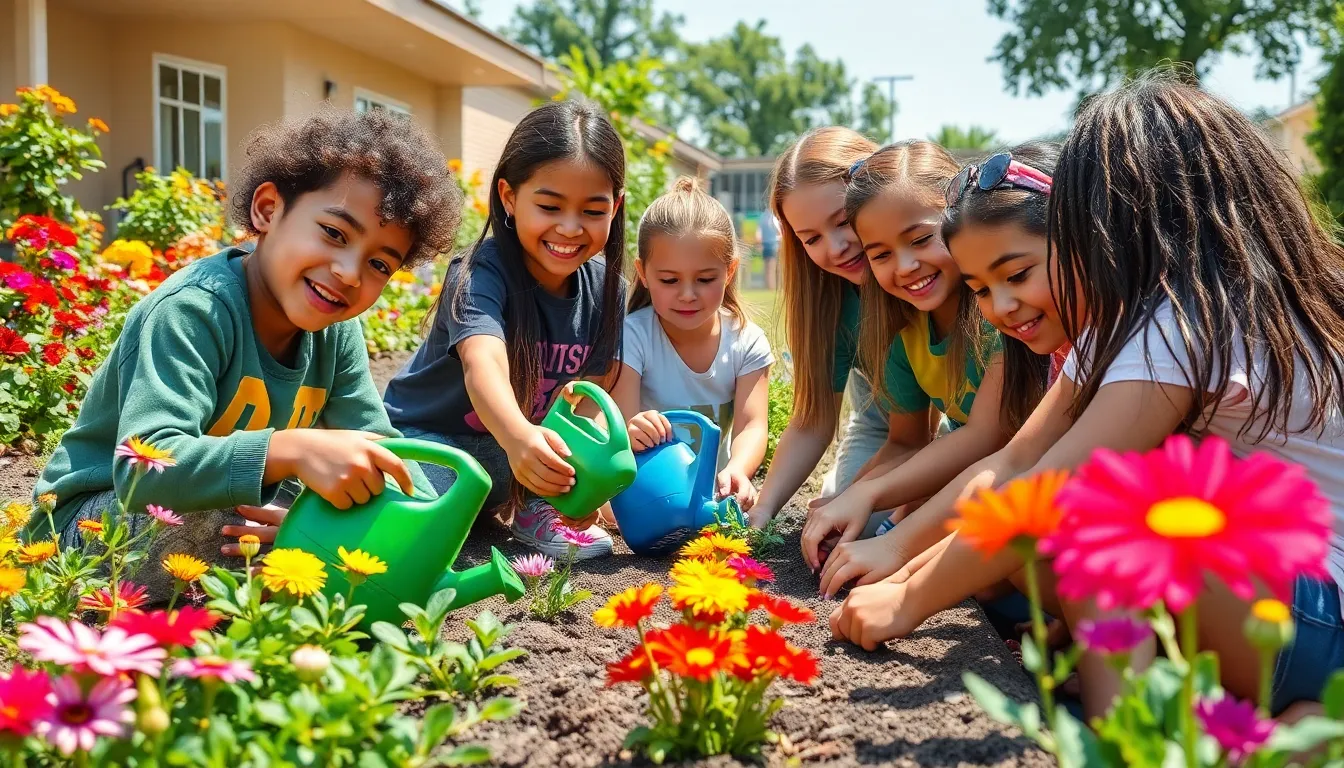Imagine a world where kids trade in their video games for shovels and seeds. School garden projects are sprouting up everywhere, turning playgrounds into vibrant patches of green. These initiatives not only beautify campuses but also cultivate a love for nature among students. Plus, who wouldn’t want to brag about growing their own tomatoes?
Table of Contents
ToggleOverview of School Garden Projects
School garden projects significantly enhance educational experiences, promoting hands-on learning and environmental stewardship. These initiatives create engaging outdoor classrooms where students cultivate plants and develop essential life skills.
Definition of School Garden Projects
School garden projects involve designing and maintaining gardens on school property. These gardens serve educational purposes, providing students with opportunities to learn about horticulture, biology, and nutrition. Such projects often include vegetable, flower, and herb gardens, allowing students to actively participate in planting, care, and harvesting.
Importance of School Garden Projects
School garden projects promote various benefits for students and communities. Engaging with nature fosters a sense of responsibility among students, as they care for living plants. Academic achievements often improve, as hands-on gardening can enhance understanding of science and math concepts. Physical health benefits arise from active participation, while social skills develop through teamwork. Overall, these projects create a deeper connection with food, encouraging healthy eating habits among students.
Benefits of Implementing School Garden Projects
School garden projects provide numerous advantages that positively impact students and schools. These projects enhance educational outcomes, promote environmental awareness, and foster social skills.
Educational Benefits
Learning through hands-on experiences enriches student understanding. School gardens act as living laboratories where students observe plant growth and study ecosystems. Engagement in gardening activities improves academic performance in subjects like science and mathematics. Students practice critical thinking skills while solving real-world problems related to nutrition and sustainability. Increased curiosity about healthy food choices comes from participating in the growing process. School gardens bolster teamwork and collaboration during planting, maintenance, and harvest times.
Environmental Benefits
Environmental awareness grows significantly through hands-on gardening. Students learn about biodiversity while planting different crops and flowers. These gardens contribute to local ecosystems by attracting pollinators like bees and butterflies. Sustainable gardening practices encourage students to appreciate and protect natural resources. Participation fosters an understanding of reducing waste by composting organic materials. Knowledge of seasonal cycles and local food systems deepens students’ connection to their environment and inspires stewardship.
Social Benefits
Social interactions flourish within school garden projects. Collaborative activities encourage teamwork, helping students develop communication skills. Sharing responsibilities nurtures a sense of belonging among students. Participation in gardening instills pride as students see their fruits and vegetables thrive. Healthy discussions about food choices and environmental responsibility become common. Stronger bonds form among peers and educators as they work together toward shared goals, creating a supportive community.
Steps to Initiate a School Garden Project
Creating a school garden project involves several key steps. These steps ensure that the project is well-planned, funded, and supported by the community.
Planning and Design
The initial phase focuses on planning and design. Gather input from students and faculty to understand preferences and needs. Establish a clear vision for the garden’s purpose, whether it’s for educational, aesthetic, or recreational use. Select a suitable location that receives ample sunlight and is accessible for all students. Incorporate various plant types, such as vegetables and flowers, to enhance biodiversity and learning opportunities. Create a detailed design layout, including pathways, planting areas, and seating. Engage students in the design process to foster ownership and excitement about the garden.
Funding and Resources
Funding plays a critical role in establishing a successful garden. Identify potential sources of funding, such as school budgets, grants, or local businesses. Apply for grants specifically targeting educational projects, such as those offered by non-profit organizations or governmental agencies. Consider launching a crowdfunding campaign to encourage parental and community donations. Leverage in-kind donations of materials or plants from local nurseries and businesses. Create a resource list detailing tools, soil, and seeds, ensuring all necessary materials are accounted for.
Community Involvement
Community involvement enriches the school garden project. Organize informational meetings to invite parents, local residents, and educators to share ideas and suggestions. Collaborate with local gardening clubs or experts for knowledge sharing and support. Encourage family participation in garden days, promoting togetherness and shared responsibility. Develop partnerships with local organizations focusing on sustainability and education. Maintain open communication with the community to keep them informed about progress, events, and opportunities for engagement.
Challenges in School Garden Projects
School garden projects face unique challenges that can hinder their success. Understanding common obstacles and developing effective strategies to overcome them ensures these initiatives thrive.
Common Obstacles
Limited funding presents a significant challenge for many school garden projects. Schools often rely on tight budgets, making it difficult to secure resources for materials and maintenance. Lack of support from administration can also impede progress, as insufficient backing may demotivate teachers and students. Additionally, inadequate knowledge about gardening practices can create hurdles, especially if educators lack training in horticulture. Weather conditions frequently play a role, as extreme temperatures and unpredictable climates can disrupt planting schedules and plant growth.
Solutions and Strategies
Developing partnerships with local organizations can effectively address funding issues. Community gardening clubs or environmental organizations often offer grants or resources to support school initiatives. Engaging parents and local businesses offers another option for resource acquisition, creating a sense of investment among stakeholders. Implementing training sessions for teachers will build confidence in managing garden projects, enhancing their effectiveness. Establishing flexible planting schedules accommodates weather variability, ensuring that students can enjoy hands-on learning regardless of conditions.
Success Stories of School Garden Projects
School garden projects have demonstrated their effectiveness in various educational settings, creating enriching environments for students.
Case Study: Urban School Gardens
Urban schools have successfully embraced garden projects, transforming limited space into vibrant green areas. For instance, one city school paired students with local gardening experts, facilitating hands-on workshops. As a result, students learned about growing herbs and vegetables, such as basil and lettuce. Participation significantly increased students’ awareness of nutrition and healthy eating habits. Additionally, these gardens served as unique outdoor classrooms, blending science lessons with real-world applications. Local businesses contributed resources, enhancing community engagement and support for the project.
Case Study: Rural School Gardens
Rural schools also benefit from garden initiatives, utilizing abundant land to foster student learning. A notable example involves a rural high school where students cultivated crops like corn and beans. Through collaboration with local farmers, students gained valuable agricultural skills and knowledge. The project encouraged students to appreciate their local ecosystem and understand sustainable farming practices. As a direct outcome, academic performance in subjects such as biology improved. Community members frequently visited the gardens, reinforcing the importance of self-sufficiency and teamwork among students.
Conclusion
School garden projects offer a wealth of benefits that extend beyond the classroom. They cultivate a sense of responsibility and teamwork among students while enhancing their understanding of the environment and nutrition. By transforming school grounds into vibrant green spaces, these initiatives not only beautify campuses but also foster a deeper connection to nature.
Through hands-on learning experiences, students develop critical skills that contribute to their academic success and personal growth. As communities come together to support these projects, they create lasting bonds and a shared commitment to sustainability and healthy living. The impact of school gardens is profound, shaping future generations to be more aware and engaged with their food sources and the environment.





